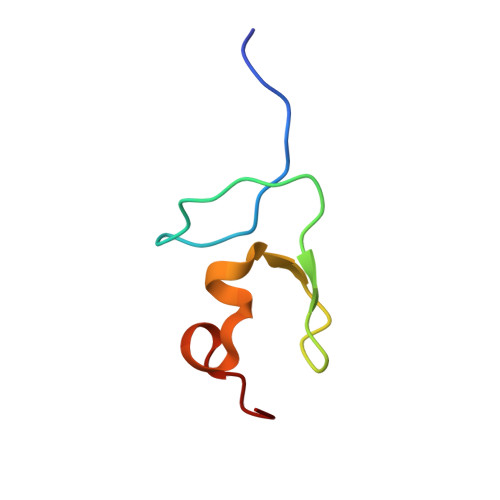Structural insight into the ZFAND1-p97 interaction involved in stress granule clearance.
Lai, C.H., Ko, K.T., Fan, P.J., Yu, T.A., Chang, C.F., Draczkowski, P., Hsu, S.D.(2024) J Biological Chem 300: 107230-107230
- PubMed: 38537699
- DOI: https://doi.org/10.1016/j.jbc.2024.107230
- Primary Citation of Related Structures:
7Y7L, 7YAB, 8HW9, 8XE8 - PubMed Abstract:
Arsenite-induced stress granule (SG) formation can be cleared by the ubiquitin-proteasome system aided by the ATP-dependent unfoldase p97. ZFAND1 participates in this pathway by recruiting p97 to trigger SG clearance. ZFAND1 contains two An1-type zinc finger domains (ZF1 and ZF2), followed by a ubiquitin-like domain (UBL); but their structures are not experimentally determined. To shed light on the structural basis of the ZFAND1-p97 interaction, we determined the atomic structures of the individual domains of ZFAND1 by solution-state NMR spectroscopy and X-ray crystallography. We further characterized the interaction between ZFAND1 and p97 by methyl NMR spectroscopy and cryo-EM. 15 N spin relaxation dynamics analysis indicated independent domain motions for ZF1, ZF2, and UBL. The crystal structure and NMR structure of UBL showed a conserved β-grasp fold homologous to ubiquitin and other UBLs. Nevertheless, the UBL of ZFAND1 contains an additional N-terminal helix that adopts different conformations in the crystalline and solution states. ZFAND1 uses the C-terminal UBL to bind to p97, evidenced by the pronounced line-broadening of the UBL domain during the p97 titration monitored by methyl NMR spectroscopy. ZFAND1 binding induces pronounced conformational heterogeneity in the N-terminal domain of p97, leading to a partial loss of the cryo-EM density of the N-terminal domain of p97. In conclusion, this work paved the way for a better understanding of the interplay between p97 and ZFAND1 in the context of SG clearance.
- Institute of Biological Chemistry, Academia Sinica, Taipei, Taiwan.
Organizational Affiliation:

















